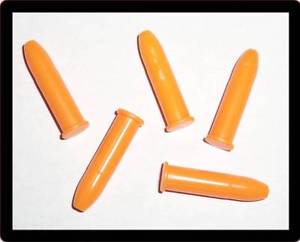DRY FIRE & IMPROVE
We all have need to dry fire.
Many top Prone and Position shooters regard dry-firing as legitimate and valuable practice. I offer the comment though, that rim-fire rifles may well be damaged by dry-firing on an empty chamber.
The firing pin may hit on the edge of the chamber, pinning the chamber so that over an extended time a round can no longer be inserted cleanly or there may be a possible damage to the actual firing pin itself and /or the chamber. Firing pins are strong, however why do something that may reduce their accuracy.
Far better to have an empty shell in the chamber. The case is softer than the firing pin and absorbs the shock. But after using lots of these fired cases in shooting practice over the years, I often noticed a small quantity of a grit-like substance, something like sand in the chamber and throat of the rifle.
On tapping a few empty cases on a table it was easy to see where the grit was coming from. It contained some fouling but appeared to be a residue from the bullet case. Consequently to fire a rifle with this in the barrel would seemingly be like firing a rifle with fine sand in the barrel.
So what is the solution?
One possibility is to fully clean the brass you are going to use for dry-firing – take care as it is harder than it sounds to get them really clean and dry on the inside!!
Another solution is to apply the “tap-test” to remove most of the loose stuff inside the brass case.
Another is to use normal cases and run the cleaning rod with a patch through the rifle before your next “live-fire” shoot to remove any residue – easy solution to protect your valuable investment.
Invest in t he plastic dry-fire bullets that resemble the real thing – although these are sometimes hard to obtain – check with your local firearms dealer, or look to the internet for online suppliers.
he plastic dry-fire bullets that resemble the real thing – although these are sometimes hard to obtain – check with your local firearms dealer, or look to the internet for online suppliers.
Whatever your solution, remember
The cases (plastic or real) will not last forever and that continual firing in the one spot make may them rather hard to extract from the chamber. After 5 shots or so, extract the plastic case and turn it around so that the firing pin will contact in a different place. Discard the plastic cases after 25 shots or so.
Use brass cases for 2-3 times only and then discard. Brass cases should be from the bullets that your rifle has fired originally – save and clean your shells
Plastic cases should be constantly checked for any sign of deterioration and then immediately discarded.
What are you trying to do when dry-firing?
Experienced shooters hear the phrase so often, they are probably yawning right now.
However, the purpose of dry-firing is
…to train the body to accept a particular course of action over time.
…to give the muscles a chance to adapt to a particular position
…it allows the shooter to quietly work on pure technique and good process, without the distraction of scores, wind, mirage, or rain.
…to train the body so that the muscles will feel comfortable and be reliable in line with the demands of the sport
…to encourage the mind and body to work as a team in the establishment, development or maintenance of a particular shooting position.
…provides excellent “brain-training” about the process of firing the good shot
…to provide an excellent and valuable “off-range” training medium
…to sharpen the senses and improve your “feel” for the position and the rifle.
Dry-Firing Works!!!!

